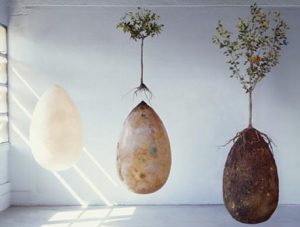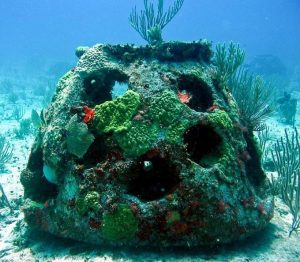What if I told you there’s a way to turn your death into something more than just an ending?
Before the solution, however, it’s important to understand the problem. Although death is difficult to face, even in hypothetical terms, we need to take a closer look at the way we carry out burials; it’s not as sustainable of a practice as we thought. Routine burial methods require large amounts of materials that are used for a short time, and every part of the process is toxic to the environment. Because of traditional embalming practices, 800,000 gallons of formaldehyde (a potential carcinogen to humans) are put into the ground annually. Additionally, in the US alone, the amount of wood used for caskets is equivalent to four million acres of forest. After the burial is over, it becomes a contributor to the one million acres of land currently used for cemeteries in the US. This land has to be maintained with fertilizer, pesticides, and massive amounts of water (Calderone, 2015). These numbers are staggering. It’s easy to see how much we’ve commercialized death.
Designers Anna Citelli and Raoul Bretzel have a solution to the toxic practices: a biodegradable burial pod that gives nutrients back to the environment and nourishes trees. They call it “Capsula

Mundi,” which translates to “world’s capsule” in Latin. The pod is made from a plastic outer shell that breaks down once it comes in contact with bacteria in the soil, and human remains are placed inside the pod (Erizanu, 2018). Because human remains release nutrients into the ground, they can be used to nourish a mature tree. When a body breaks down, it releases large amounts of nitrogen, but the plastic shell releases carbon in an effort to balance out chemical levels in the soil. Their design isn’t currently legal everywhere, but it’s allowed in North America (“Capsula Mundi”).
The designers of the Capsula Mundi pods are reimagining cemeteries as land filled with trees and wildlife. They want to help people understand that death can be turned into life by helping the environment flourish. The one million acres of cemetery land and tombstones can become wide expanses of woodlands.
 For the people more passionate about ocean life than trees, there are still options for a sustainable burial- Eternal Reefs. A similar concept to the Capsula Mundi, reef pods are created from human remains and an environmentally-safe cement mixture. These pods are then used to foster new habitats for sea life. There are currently 1800 Eternal Reefs created by people in the United States, but the company is quickly growing. Families can write in the concrete before it hardens and hold a service on the water as the reef pod is placed in a location of their choosing (“What is an Eternal Reef?”).
For the people more passionate about ocean life than trees, there are still options for a sustainable burial- Eternal Reefs. A similar concept to the Capsula Mundi, reef pods are created from human remains and an environmentally-safe cement mixture. These pods are then used to foster new habitats for sea life. There are currently 1800 Eternal Reefs created by people in the United States, but the company is quickly growing. Families can write in the concrete before it hardens and hold a service on the water as the reef pod is placed in a location of their choosing (“What is an Eternal Reef?”).
These solutions are the first attempts to transform our idea of death and to help people dedicate themselves to helping the environment. It’s hard to grasp the idea that our lifespan is finite, but just because human life has an expiration date doesn’t mean the environment has to follow suit.
-Haley Park
References:
Calderone, Julia. “Burying Dead Bodies Takes a Surprising Toll on the Environment.” Business Insider, Business Insider, 4 Nov. 2015, www.businessinsider.com/burying-dead-bodies-environment-funeral-conservation-2015-10/#eco-friendly-alternative-do-exist-6.
“Capsula Mundi >> Project.” Capsula Mundi, www.capsulamundi.it/en/project/.
Erizanu, Paula. “Organic Burial Pod Turns Your Body into a Tree.” CNN, Cable News Network, 11 Jan. 2018, www.cnn.com/2017/05/03/world/eco-solutions-capsula-mundi/index.html.
“What is an Eternal Reef? >>Eternal Reefs >> Living Legacies That Memorialize the Passing of a Loved One.” Eternal Reefs, www.eternalreefs.com/the-eternal-reefs-story/what-is-an-eternal-reef/.